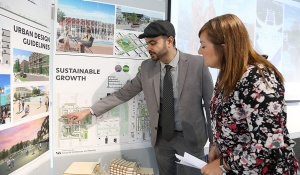Master of Urban Planning

Offering a fully accredited Master of Urban Planning program in the State University of New York (SUNY) system, our students work in partnership with faculty to connect the art of planning with policymaking, community advocacy, geospatial analysis, and more.
Begin your path to building healthy, equitable, and vibrant communities with courses in economic development, environmental and land use planning, transportation, community health and food systems, housing, neighborhood planning and community development, and urban design. Our curriculum emphasizes creative thinking, community impact, and sustainability. Customize your education with a two-year program involving real projects, real clients, in real time — designed for post-graduates from all majors and working professionals.
Study under our renowned research centers, including the Center for Inclusive Design and Environmental Access (IDEA), WHO Collaborating Center on Health in Housing, Center for Urban Studies, Food Systems Planning and Healthy Communities Lab, and the UB Regional Institute where we apply local and international expertise to improve the lives of real people and the places they inhabit.


Duration of Study
- 2-yr Program (52 credit hours)
Cost of Study
- Domestic: $5,655 - $12,870
- International: $12,870
*per semester tuition rates and does not include fees
Admissions requirements
- Application fee: $75
- No GRE required
Student Life
The two-year Master of Urban Planning degree provides students with the interdisciplinary knowledge, skills, and practical experience to become professional planners. It is built around a core curriculum, professional competencies, two planning studios, elective courses, and a culminating professional project or thesis. The curriculum foregrounds urban sustainability and social justice with courses and applications in the areas of land use and urban development, environmental planning and climate adaptation, housing, sustainable transportation, urban design, historic preservation, economic development, community health and food systems, global and international development. Our program is fully accredited by the Planning Accreditation Board, and our alumni work in public local, state, and federal agencies, local and international nonprofit organizations, and private land development and consulting firms.


